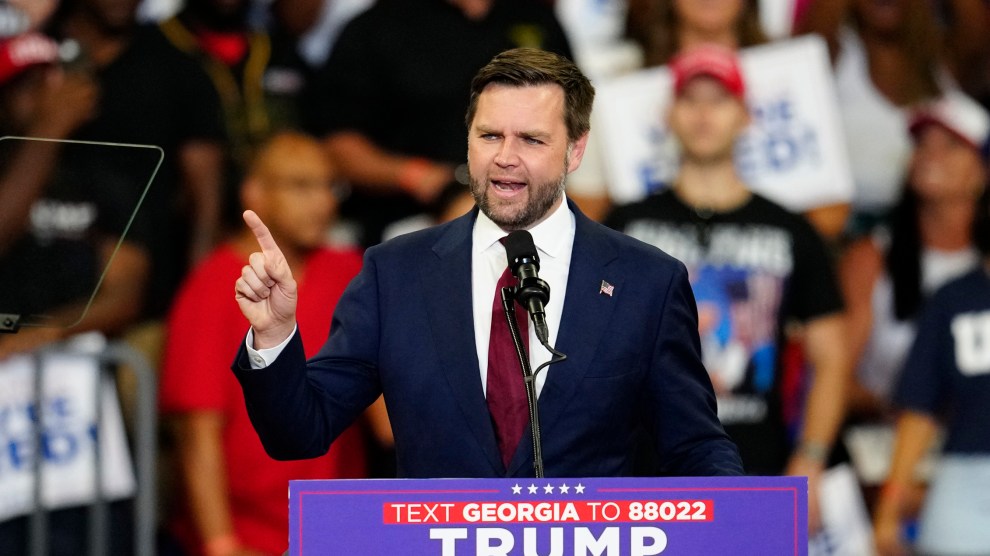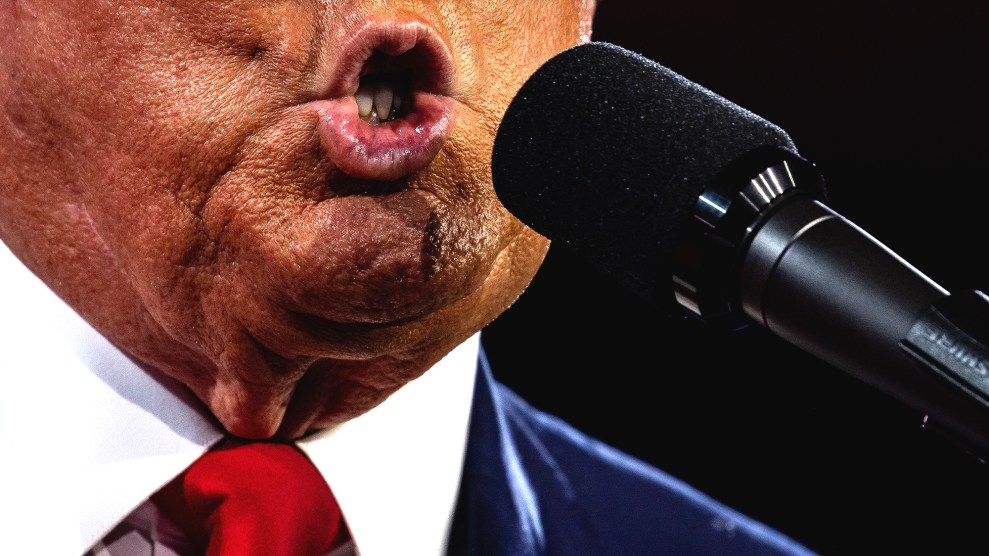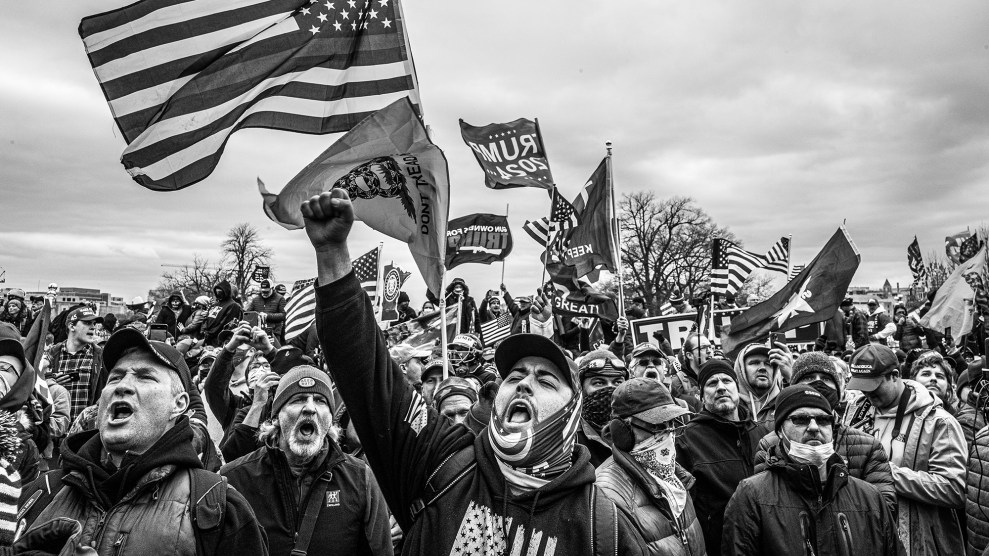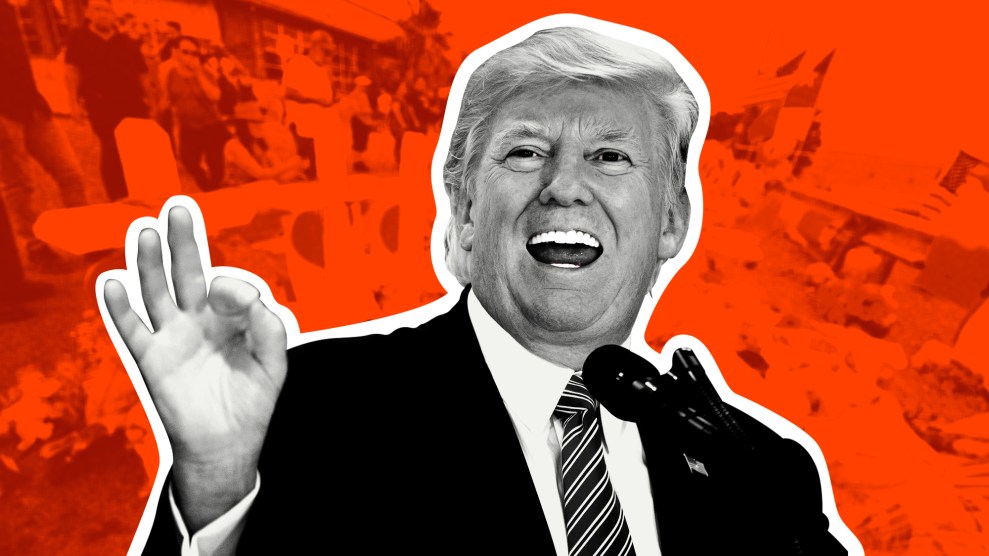
Mother Jones; Carol Guzy/ZUMA (2)
On the morning of August 3, 2019, a 21-year-old man walked into a Walmart in El Paso, Texas, and opened fire with a semiautomatic rifle. He murdered 23 people and injured 22 others. Most who died were Latino, including eight people from Mexico.
The gunman had driven to the border city from 650 miles away. In custody, he told police he’d come to kill Mexicans. Some writings he’d posted online said his attack was “a response to the Hispanic invasion of Texas” and that his mission was “defending my country from cultural and ethnic replacement brought on by an invasion.” He cited an extremist ideology known as “The Great Replacement.”
These were not obscure ideas. The gunman wrote that he agreed with a recent mass shooter in New Zealand who had espoused them. He also knew some of these themes were being championed at the time by President Donald Trump. With help from Fox News pundits, Trump was whipping up fear and hatred of an alleged “invasion” coming across America’s southern border—the message was central to Trump’s reelection campaign in 2019, a focus of his ads and speeches warning ominously of a national demise.
At the end of the shooter’s screed posted online, he sought to validate his attack with a pseudo-clever twist, suggesting that his views predated Trump in the White House. “I know that the media will probably call me a white supremacist anyway and blame Trump’s rhetoric,” he wrote. Then he used Trump’s own rhetoric as supporting ammo: “The media is infamous for fake news.”
Today, Trump is running again using the same potent demagoguery he wielded during his presidency and prior campaigns. Five years to the day after the massacre in El Paso, he held a rally in Atlanta with running mate JD Vance, and, over the course of an hour, warned a half dozen times about hordes of murderous foreigners overrunning America.
“Forty or fifty million illegal aliens will invade our country during the next four years if they’re in,” Trump said of his Democratic opponents at the outset. He soon continued: “Many of them that are coming in are from prisons and jails and mental institutions, insane asylums.” He taunted media covering the rally as he referenced the fictional serial killer Hannibal Lecter, a provocation he now uses to depict migrant “insanity” and brutality.
He went on to vow he would “stop the invasion” and expanded on the peril: “These people are so violent and vicious…These are the worst people anywhere in the world coming into our country. They’re coming in at levels that nobody’s ever seen before.”
“We’ve already seen where this goes and it can easily go there again,” one threat assessment source told me.
Audience reaction was relatively subdued as Trump recited these lines from a teleprompter, perhaps because they are such a familiar fixture of his speeches. But deep into this speech, the next escalation played differently. The danger, Trump now further alleged, came from a grand conspiracy against him, one involving migrants. He warned that his political opponents who “hate our country” are “actually trying to get them to sign up and vote.” Then came the climax: “It’s so sinister,” he said, “but they want to sign these people up to vote, and if they do that, this country is destroyed. We’d become a dumping ground for the entire world, and we’re not going to take it anymore.”
A close listener could hear echoes of Jan. 6, 2021, when Trump invoked loss of country and the danger of inaction against an election that he falsely claimed was stolen from him. Now, in his telling, that conspiracy promised to use legions of evil foreigners against him and his supporters.
The crowd cheered, beginning to stir more as Trump recounted a recent murder of a university student at the hands of a Venezuelan man illegally in the country. “Kamala Harris let in the savage monster who murdered Laken Riley,” Trump declared. He railed against “migrant crime” and falsely claimed that “thousands” of Americans were being killed in this way.
He continued: “If Harris wins, a never-ending stream of illegal alien rapists, MS-13 animals, and child predators will flood into your communities. If I win, on day one we will begin the largest deportation operation in American history.”
The crowd roared at this signature line from his speech.
“We have no choice,” Trump said.
Who was listening? Perhaps some disturbed young man there in the crowd, or elsewhere watching Trump live on YouTube—perhaps someone who might feel enraged, like the El Paso mass shooter surely did when he wrote down the lie that Democrats “intend to use open borders, free healthcare for illegals, citizenship and more to enact a political coup by importing and then legalizing millions of new voters.”
Shortly after Trump’s speech in Atlanta, I talked to a longtime threat assessment source with expertise in counterterrorism and far-right extremist groups. His response was blunt when I noted that no major media focused their coverage on Trump’s inflammatory language, almost as if all that rhetoric was just business as usual.
“There’s nothing normal about any of this,” the source said. “We have the First Amendment and he can say whatever he wants, that’s our democracy. But it really disturbs me how politicians in his party won’t stand up and say one word against it now. The country really needs that. We’ve already seen where this goes and it can easily go there again.”
The use of Trump’s rhetoric to justify racist and organized political violence began early in his presidency. Strained denials of that reality crumbled for good with the horrific events at the US Capitol on Jan. 6, 2021. This June, I reported again on Trump’s years of incitement against his many perceived enemies, a method known to national security experts as stochastic terrorism. The results, as I’ve reported, grow even worse when a high-profile figure emphasizes themes of contempt and disgust.
Security and law enforcement sources told me that topping the list of concerns now for election-year violence are threats stemming from white supremacist groups and Trump’s MAGA movement. After the assassination attempt against the ex-president in mid-July, sources told me that the promotion of conspiracy theories and false blame on Democrats by Trump allies could provoke retaliatory attacks.
At the Aug. 3 rally in Atlanta, JD Vance doubled down on that very blame, declaring in his speech that Trump’s political opponents “tried to kill him.” Meanwhile, a new intelligence report from the FBI and Homeland Security focused on the upcoming Democratic National Convention highlights similar concerns about retaliatory violence.
I contacted three people with the Trump campaign asking specifically for comment on these warnings about political violence: spokespersons Brian Hughes and Steven Cheung, and Trump senior advisor Alina Habba. None of them responded.
America faces immense challenges with immigration, a top issue for voters. It is precisely that reality Trump seeks to exploit.
Trump shows no signs of stopping the incitement. Last Thursday, in a rambling speech to reporters assembled for a press conference at Mar-a-Lago, he again emphasized that America was under invasion by millions of migrants “from prisons, from jails, from mental institutions, insane asylums.” They are flooding in “from all over the world,” he claimed. “Prisons are being emptied into our country.”
He delivered more of the same at a rally on Friday in Montana: “Fifty million of them… they’re destroying our country, they’re ruining our country… migrants praying on our women and our girls.”
Fear and loathing, dressed up as just another stump speech.
Trump’s incitement focused on migrants is not mutually exclusive with the fact that America faces immense challenges with immigration, a top issue for voters. It is precisely that reality Trump seeks to exploit. In early 2024, Congress was poised to pass a bipartisan border security bill, with President Biden ready to sign it. Trump killed the deal. No one bothered trying to hide why he pressured Republicans to do his bidding: He wanted immigration to remain his political weapon.
“The fact that he would communicate to Republican senators and Congress people that he doesn’t want us to solve the border problem, because he wants to blame Biden for it, is really appalling,” Republican Sen. Mitt Romney of Utah told reporters in January, the deal dead.
Republican Sen. James Lankford of Oklahoma, who helped author the legislation, later revealed how “a popular” media commentator had threatened him: “If you try to move a bill that solves the border crisis during this presidential year,” that Trump ally told him, according to Lankford, “I will do whatever I can to destroy you. Because I do not want you to solve this during the presidential election.”
What else might follow when the leader of a major political movement smears a population as a menace to public health and safety and even national survival?
Trump’s relentless fear-mongering against migrants underscores how he has always seen immigration and the border as essential to his political power. There is zero doubt that his current trajectory—begun nearly a decade ago when he announced his first campaign and inveighed against Mexican criminals and “rapists”—will continue to the November election.
Most news media are no longer paying any of this much attention. But that carries risk of the public forgetting about the violence that has already occurred. More broadly, shouldn’t we be asking: What else might follow when the leader of a major political movement smears a population as a menace to public health and safety and even national survival?
According to one of Trump’s own senior national security advisers in the White House, Trump was informed explicitly and repeatedly about how his rhetoric had been used to justify acts of violence. Credible evidence of his awareness—and his demonstrated unwillingness to respond meaningfully against the violence—suggests that, for him, more bloodshed will be welcome.

















